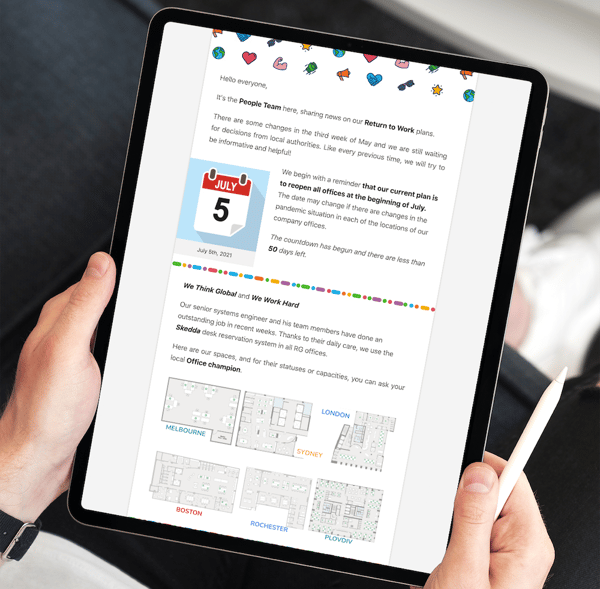Over the next couple of months, many of our employees (who have been working remotely for the past year) will start to venture back into our offices and workplaces more regularly – if they haven’t already. In honour of Stress Awareness Month, I wanted to acknowledge how adapting to another change may cause some stress or discomfort.
If your employees are feeling particularly anxious about this change, I have some tips for you to try to help reduce their anxiety as we return to the office:
| 1. Give guidance on new routines |
| 2. Communicate about your company's policies |
| 3. Help your people manage symptoms of anxiety |
| 4. Make wellbeing a top priority for all |
| 5. Get out in nature |
1. Give guidance on new routines
Working from home has seen a change to our normal, daily routine. I am sure many people have climbed straight out of bed and logged onto work emails while still in their pajamas at least once. Encourage employees to take time in the morning for themselves (if possible) before jumping into work or a commute.
 Another piece of the new routine puzzle is food. Snacking and grazing might be a lot easier when you’re at home and have free access to your fridge or pantry whereas working in the office or on site might mean employees need to be more conscious about scheduling in meals or breaks. Where it’s suitable, promote this as a positive adjustment that can help promote a healthier lifestyle (bonus: this can help ward off sickness and strengthen immunity).
Another piece of the new routine puzzle is food. Snacking and grazing might be a lot easier when you’re at home and have free access to your fridge or pantry whereas working in the office or on site might mean employees need to be more conscious about scheduling in meals or breaks. Where it’s suitable, promote this as a positive adjustment that can help promote a healthier lifestyle (bonus: this can help ward off sickness and strengthen immunity).
One thing I recommend is to build in 'transition time' so your mind has a chance to switch on/off between work and home commitments.
When the 'back to work' day begins to loom, encourage employees to try to prepare their body by getting back to their old routines.
2. Communicate about your company’s policies
Line managers have the duty of making employees feel safe and ensuring that the workspace remains COVID-free. Before employees head back to the office, it’s important for HR to take time to speak to managers about any of the concerns employees may have.
Once equipped with the right information, managers should be able to fill employees in on all the procedures they have in place. Learning these before employees return will help reassure them that their safety and wellbeing remain a top priority.
An internal communications tool can be especially helpful here to keep all employees informed and updated about what to expect when returning to the office. Here’s an example of our 'Return to Work' series that’s published every Friday by one of our Experience Managers. It gives our 450+ employees insight into new mandates, regulations and happenings across the globe. Our people can then react to or comment on the post, helping to increase visibility on changes and enable two-way feedback to voice any concerns they may have.

3. Help your people manage symptoms of anxiety
Be mindful that your people went through a big change last year, and now we’re asking them to adapt yet again. Feelings of anxiety will manifest themselves as a series of uncomfortable symptoms, which in turn might lead to panic attacks that will only exacerbate the situation.
 If your people are experiencing anxiety, hold sessions on grounding techniques for them to use before they go into the office (or get back on a crowded train) so they can stay on top of them, should they begin to flare up.
If your people are experiencing anxiety, hold sessions on grounding techniques for them to use before they go into the office (or get back on a crowded train) so they can stay on top of them, should they begin to flare up.
Deep breathing is a perfect 'on the spot' technique to help calm nerves as well. By taking deep breaths you encourage more carbon dioxide into your bloodstream which will help regulate your heartbeat and feelings of 'fight or flight.' Mindfulness techniques such as yoga or meditation will also help to keep you focussed.
An employee wellbeing program can help your people manage stress and focus inward to feel calmer – with fitness videos, guided meditations or tips for better sleep – all geared towards improving mental health.
4. Make wellbeing a top priority for all
Although many people have received the COVID-19 vaccine, returning to rooms full of people will be a shock to the system given that our people have been out of contact for such a long time. It is so important to eat the right foods, including plenty of fresh fruit and vegetables to ensure you are packed full of vitamins and minerals. Keep fresh produce around the office and encourage employees to opt for a healthier choice throughout the day.
Also, remind people to stay hydrated – this will help flush out any bugs and improve immunity. Posters around the office can be helpful to remind people to drink lots of water or to get into the habit now of wearing a mask for longer periods of time.
Lastly, stock up the office on hand sanitiser or set up stations where employees can sanitise after they get into the office from a long commute.
5. Get out in nature
 Nature is central to our psychological and emotional health, that it’s almost impossible to realise good mental health for all without a greater connection to the natural world.
Nature is central to our psychological and emotional health, that it’s almost impossible to realise good mental health for all without a greater connection to the natural world.
For most of human history, we lived as part of nature. It is only in the last five generations that so many of us have lived and worked in a context that is largely separated from nature.
Here are some ways to encourage employees to reconnect with nature at work:
- Take a lunch break: It’s so important to take a proper break during the day. Instead of eating at their desk, ask an employee to grab a sandwich and get outside to your nearest green space. Sit somewhere quiet and just listen to the sounds of nature. You’re sure to come back feeling refreshed and energised.
- Adventure locally: So many of us become complacent about all of the beautiful places near to where we live or work. Try becoming a tourist in your own town or city – grab a group of people to visit a park you have never been to for a picnic or go to a local restaurant for a mid-week happy hour.
- Create a scavenger hunt: Employees are going to want to come to the office if something fun or new is happening. Plan a scavenger hunt around the city you work in and use it as a team-building exercise. Many people have seen each other over Zoom the past year, but there’s nothing like face-to-face interaction!
Returning to the office can cause mixed emotions for employees, but it’s an employer’s job to make the office a welcoming and safe place to be. With the right mix of communications, wellbeing tips and team-building exercises we can work towards easing employees’ stress about yet another change in their daily lives to help them feel excited about the office again.
Do you have some good tips for helping employees return to the workplace? I’d love to hear more from you, feel free to send me a message on LinkedIn!
 Kaitlin Howes
Kaitlin Howes

